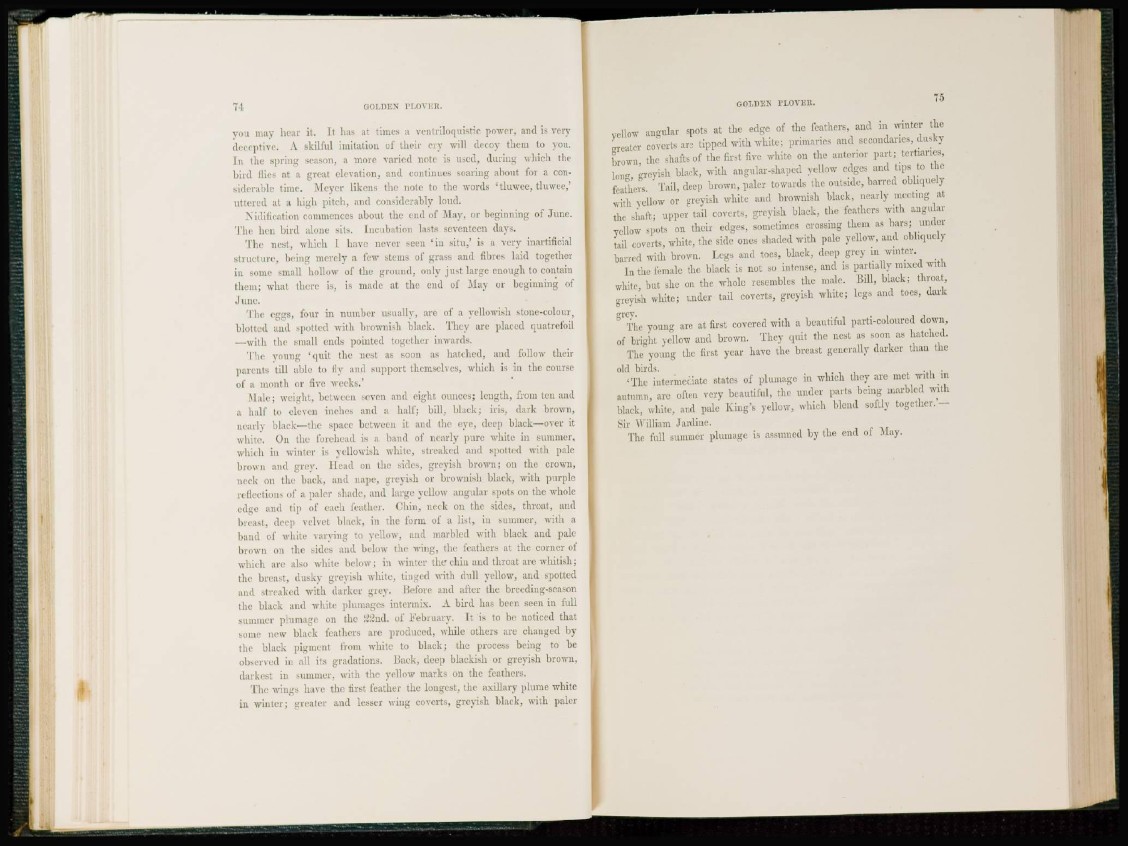
74 GOLDEN PLOVER.
you may hear it. It lias at times a ventriloquistic power, and is very
deceptive. A skilful imitation of their cry will decoy tlicm to yon.
I n the spring season, a more varied note is used, during which the
bird liies at a great elevation, and continues soaring about for a considerable
time. Meyer likens the note to the words 'tluwce, tluwcc,'
uttered at a high pitch, and considerably loud.
Nidification commences about the end of May, or beginning of June.
The hen bird alone sits. Incubation lasts seventeen days.
The nest, which 1 have never seen ' i n situ,' is a very inartificial
structure, being merely a few stems of grass and fibres laid together
in some small hollow of the ground, only just large enough to contain
them; what there is, is made at the end of May or beginning of
June.
The eggs, four in number usually, arc of a yellowish stone-colour,
blotted and spotted with brownish black. They arc placed quatrefoil
—with the small ends pointed together inwards.
The young 'quit the nest as soon as hatched, and follow their
parents till able to fly and support themselves, which is in the course
of a month or live weeks.'
Male; weight, between seven and eight ounces; length, from ten and
a half to eleven inches and a half; bill, black; iris, dark brown,
nearly black—the space between it and the eye, deep black—over it
while. On the forehead is a hand of nearly pure white in summer,
which in winter is yellowish wdiile, streaked and spotted with pale
brown and grey. Head on the sides, greyish brown; on the crown,
neck on the back, and nape, greyish or brownish black, with purple
reflections of a paler shade, and large yellow angular spots on the whole
edge and tip of each feather. Chin, neck on the sides, throat, and
breast, deep velvet black, in the form of a list, in summer, with a
band of while \ ar\ ing to yellow, and marbled with black and pale
brown on the sides and below the wing, the feathers at the corner of
which are also white below; in winter the"chin and throat are whitish;
the breast, dusky greyish white, tinged with dull yellow, and spotted
and streaked with darker grey. Before and after the breeding-season
the black and white plumages intermix. A bird has been seen in full
summer plumage on the SJSnd. of February. It is to be noticed that
some new black feathers are produced, while others arc changed by
the black pigment from white to black; the process being to be
observed in all its gradations. Back, deep blackish or greyish brown,
darkest in summer, with the yellow marks on the feathers.
The wings have the first feather the longest, the axillary plume white
in winter; greater and lesser wing coverts, greyish black, with paler
GOLDEN PLOVER.
yellow angidar spots at the edge of the feathers, and in winter the
greater coverts arc tipped with white; primaries and secondaries, dusky
brown, the shafts of the first five white on the anterior part; tcrtiarics,
long, greyish black, with angular-shaped yellow edges and tips to the
leathers. Tail, deep brown, paler towards the outside, barred oblicjucly
with yellow or greyish white and brownish black, nearly meeting at
the shaft; upper tail coverts, greyish black, the feathers with angular
yellow spots on their edges, sometimes crossing them as bars; under
tail coverts, white, the side ones shaded with pale yellow, and obliquely
barred with brown. Legs and toes, black, deep grey in winter.
In the female the black is not so intense, and is partially mixed with
white, bat she on the whole resembles the male. Bill, black; throat,
greyish white; under tail coverts, greyish white; legs and toes, dark
grey.
The young are at first covered with a beautiful parti-coloured down,
of bright yellow and brown. They quit the nest as soon as hatched.
The young the first year have the breast generally darker than the
old birds.
'The intermediate states of plumage in which they are met with in
autumn, are often very beautiful, the under parts being marbled with
black, white, and pale King's yellow, which blend softly together.'—
Sir William Jardine.
The full summer plumage is assumed by the end of May.